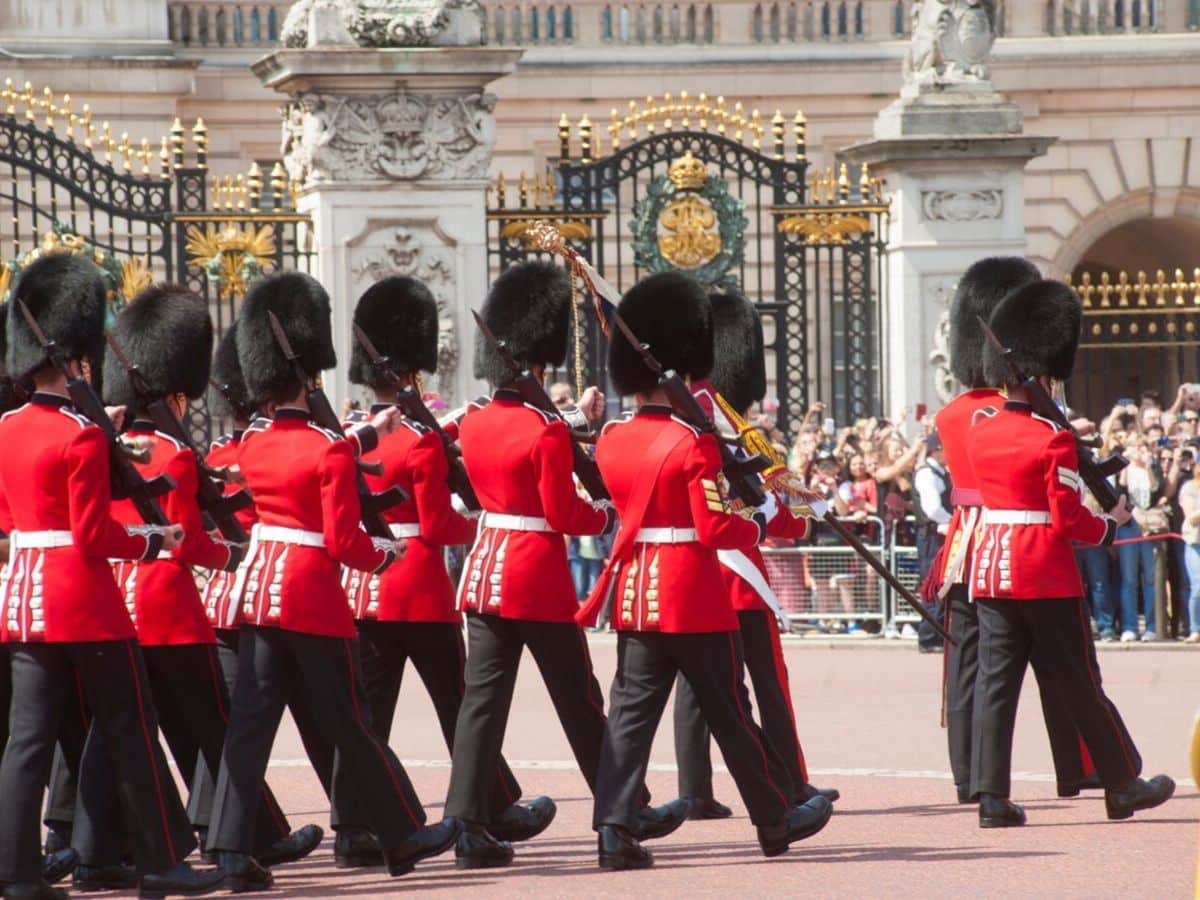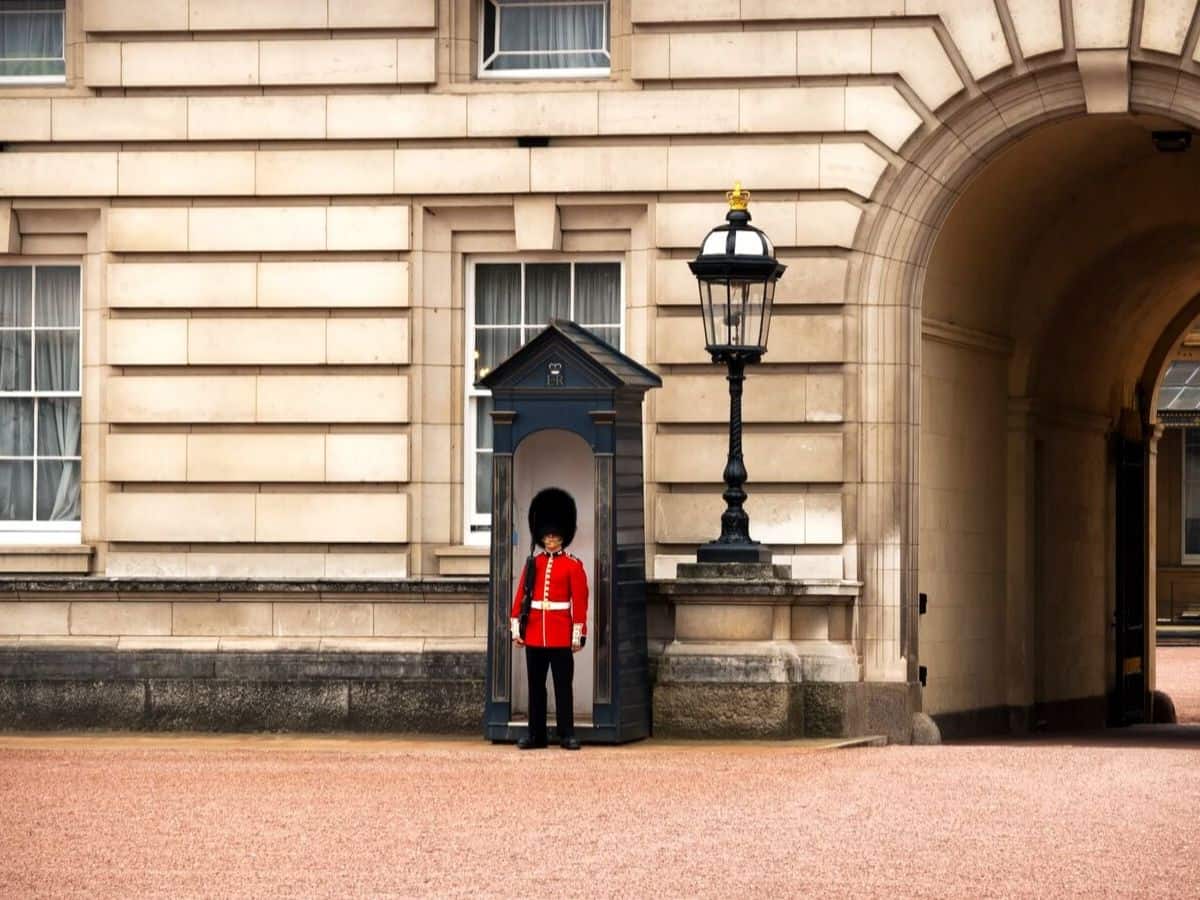Protecting one of the London’s most iconic buildings and safeguarding the world’s most high-profile royal is no easy task. Masked by the magnitude of their bearskin hats and pristinely turned out red tunic uniforms, everything about the Queen’s foot guards oozes mystery. Luckily, as regular visitors to Buckingham Palace, we’re here to uncover everything there is to know about the Queen’s guards.
The British royal family are a favorite subject of the media worldwide. Their lavish lifestyles and quirky customs have captured the curiosity of many. Sometimes it’s easy to forget that it isn’t just royalty living behind the opulent gates of Buckingham Palace. Although their lives are much more low-key than that of the royal family, we can’t deny that the jobs of their staff are equally as fascinating. So here we have it, the 7 most interesting things we’ve learnt about the Queen’s guards.
1. The Story Behind those Bearskins Caps
Although not worn by the Yeomen Warders, the fuzzy bearskin caps are an iconic feature of the royal guards’ uniform. The origin of these seemingly excessive helmets dates back to the 18th Century. At the time, the gunner in British and French armies wore these enormous bearskin caps to make them appear taller. This was believed to intimidate their opponents. The French Emperor Napoleon dressed his imperial guards in similar hats while he was in power in the early 19th Century. During the great Battle of Waterloo, as the British defeated Napoleon’s army they collected the bearskin caps from the corpses of Napoleon’s men and brought them home as trophies.
Curiously, these caps are secured under the lip of the guards (by a curb chain) as opposed to under the chin. This is to protect the guard’s neck in combat. The hat is so heavy that if it was tied beneath the chin and the guard was shot during an attack, causing the hat to drop backwards, the guard’s neck could snap in the process. The Bearskin Cap is said to get its name because inside is a cap that fits snug to the head of the wearer.
2. You Need a Strong Neck to be a Royal Guard

Royal guards marching outside Buckingham Palace
The Queen’s royal guards have got some neck. No, seriously! Those massive bearskin caps, 18 inches in height, can weigh up to 1.5 pounds. You’d have to have a very strong neck to carry that for the entirety of your shift. And that’s not all, these hats get even heavier when they get wet - and let’s face it, that’s pretty often in London.
3. The Foot Guards Will be From One of Five Regiments

The Royal Tower of London
These five regiments are the Grenadier Guards, the Coldstream Guards, the Scots Guards, the Irish Guards and the Welsh Guards. Their uniforms all differ slightly - for example, the Grenadier Guards have single buttons evenly spaced, with a white plume on the left of their cap. You’ll notice a grenade on the collar badge. The Coldstream Guard, however, have pairs of buttons and the plume on their cap is red. The Scots Guards have buttons in threes with no plume on their caps, but a thistle badge on their collar. For the Irish Guards you’ll notice the buttons are in groups of four, and they have a blue plume on the right of the cap as well as a shamrock on their collar badge! Last but not least, the Welsh Guards have buttons in fives with a white and green plume on the left of the cap, and leeks on their collar badges. See who you can spot on your visit!
4. They Protect more than just Buckingham Palace
While we might generally associate these red tunic clad guards with Buckingham Palace, they actually also protect other royal landmarks too. In fact, the Foot Guard regiment have the role as the primary garrison for the capital, for military security of the Sovereign, and also for ceremonial duties in London. You’ll see Foot Guards at Wellington Barracks (Buckingham Palace), Victoria Barracks (Windsor) as well as the Royal Artillery Barracks (Woolwich).
There are no sentries guarding Edinburgh Castle, except for when a Royal Visit occurs. However, this is likely to be one of the Foot Guards!
5. They Won’t Smile for a Selfie

Royal guard stands to attention outside Buckingham Palace
Visitors to Buckingham Palace love provoking the royal guards in a bid to get them to smile. But their attempts are in vain. No matter how many jokes you make or photos you take the royal guards’ somber expression won’t crack. Although they’re a popular spectacle for visitors to Britain, wishing to observe as they perform their iconic Changing of the Guard, these guards are in active service to the Queen and must carry themselves with the upmost discipline. They won’t be fined, as some rumours suggest, but it is frowned upon for guards to smile for a selfie with tourists.
6. No Toilet Break for the Dedicated Soldiers
The Queen’s guards are so dedicated to their position that they can’t even leave their post for a toilet break during their working shift. They must all have pretty strong bladders!
7. They can Break their Silence in some Circumstances
Although we’d be forgiven for believing that the Queen’s guards have taken a vow of silence while in post, they can indeed speak on some occasions. Although we do not recommend provoking them to do so, the can speak (or more specifically yell) if visitors come to close to them or acts aggressively. They are most commonly known shout “make way for the Queen’s guard!” at tourists who get too close.
Everything about the British royal family, their residence and their staff is fascinating. With traditions steeped in centuries of history, visiting the Queen’s palaces and witnessing royal customs in action is a quintessentially British experience and one you cannot miss on your visit to London. Experience the very best this historic capital has to offer in the company of an expert guide as you join us on our best London tours.


